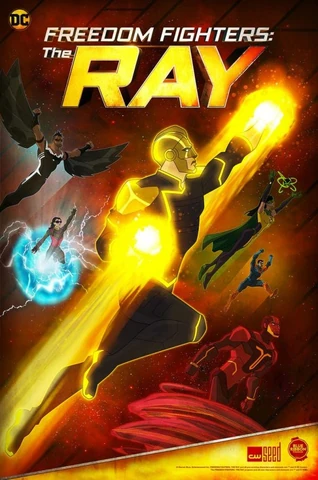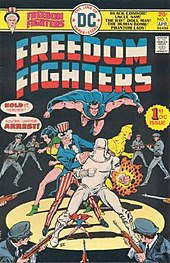 Freedom Fighters: The Ray
Freedom Fighters: The Ray
Last month's huge CW Crisis on Earth-X storyline made the surprise debut of the Ray, handling his surprise introduction very well and quickly inserting his status as a gay dimension-hopping superhero that originated from 'our' Earth-1 and somehow traveled to the Nazi-run Earth-X and became a light-wielding superhero there pretty well. There's a huge amount of mystery as to who this Ray Terrill is, how he hopped worlds, and just his backstory in general. It's fascinating.
(Also, if you haven't watched Crisis on Earth-X, shame on you!)
The Ray gets his little animated show on CW Seed, something that was previously used to debut the superheroine Vixen before she made the transition from cartoon to live-action. It's a neat little way to show off characters with more outlandish superpowers like Vixen or Ray (or Red Tornado and Phantom Lady, both shown here) without blowing up the various shows' budgets for visual effects. I still think that the animated shorts are criminally underused and there's too little of them for even a hardcore CW/DC fan like me to pay a lot of attention to, and I really wish that even if a proper cartoon series is out of the plate, we could've debuted a couple more characters in these shows.
Still, let's talk about Freedom Fighters: the Ray first. It's split up into six mini-episodes, each lasting around 5 minutes, just like Vixen was. It's a very fucking weird way to handle a show, and I'd rather just the whole thing be touted out as a thirty minute mini-movie of its own. More strangely, this first season/installment of the Ray ended in a huge, abrupt cliffhanger of the Ray being knocked out with a sleeping dart out of his home. It's bizarre, to say the least.
The first two 'episodes' of Freedom Fighters: The Ray takes place in the Nazi-controlled universe of Earth-X, and we get to see the cast of the Freedom Fighters -- a relatively obscure DC superhero team, and one of the many that DC comics 'purchased' from other smaller superhero companies but never quite utilized as much as others like Blue Beetle or Captain Marvel. The Freedom Fighters enjoyed a role as DC's canonical 'World War superhero' group alongside the first incarnation of Justice Society, and make a crapton of cameos whenever a big Event (tm) needs a bunch of extra bodies, but they've been woefully underused other than the Ray himself. I'm just super-pleased that four of the six classic members of the Freedom Fighters ends up showing up in an animated feature (we're only missing Uncle Sam and the Human Bomb).
And as a huge superhero geek, the first two episodes that focused primarily on the Earth-X Freedom Fighters battling against Nazi superheroes is the best parts of the season. The Freedom Fighters' ranks consist of the titular Ray and a surprisingly chatty Red Tornado (who shows up mute in Crisis), as well as Phantom Lady, Black Condor and Doll-Man. Oh, as well as the Earth-X version of Cisco "Vibe" Ramon. There's a bit of disconnect with Crisis on Earth-X where there's apparently an evil version of Barry Allen -- apparently called the insanely awesome name of "Blitzkrieg" by the credits -- running around Overgirl and Dark Arrow, while other characters from Crisis like Resistance Leader Winslow Schott, Guardian or Citizen Cold are missing... and there's the weird disconnect that it's Overgirl that everyone salutes instead of Fuhrer Oliver... but eh. I like that we just have this awesome show of nazis fighting against reimagined versions of the Freedom Fighters.
Considering none of these 'classic' characters show up on Crisis on Earth-X, you might be forgiven for thinking that they're disposable, and... you're kind of right. Red Tornado's chatty and all, but the show quickly has him face off against Overgirl in a very cool underwater sequence where Overgirl rips off his arms and heat-visions the shit out of his head. And Doll-Man gets heat-visioned through the chest with his corpse being shown with a surprisingly graphic showcase of the cooked ribcage and organs within. We last see Earth-X's Black Condor and Phantom Lady fighting against the combined forces of Dark Arrow, Overgirl and Blitzkrieg, and while we don't see them die per-se, it's not looking good for them. The Ray is sent through a portal by Earth-X's Vibe, holding the critical information contained within Red Tornado's brain.
And then smash-cut to episode 3... and we get to see Ray, Condor and Phantom Lady as civilians trying to sell some kind of altruistic for-the-community housing department... only to be laid off by his evil money-grubbing politician boss who doesn't give a shit about people who didn't vote for him (I'm not sure if it's intentional, but the credits give his name as 'Donald'). This cuts to a civilian life as Ray and John (Black Condor) hang out in the bar, with John trying to get Ray to hit on some men, while Ray talks about how his father is overbearing and approves of neither Ray's career choices or sexuality (if he ever finds out). It's a pretty cool storyline that emphasizes Ray's gayness, but I feel like it's a huge disconnect and trying to do a bit too much... although it is cool as hell when the huge plot twist in episode 3 happens, and Earth-X Ray shows up in front of this civilian Ray... and Earth-X Ray dies, passing his powers (and Reddy's brain) to Earth-1 Ray. It's a neat little twist that ties together both sides of the story and explains just why the Ray that we saw in Crisis claims to have came from Earth-1.
Episodes 4-6 is a bit more sporadic, though. We get your obligatory cool scenes of Ray figuring out his powers for the first time (including a very cool dematerialization ability that I don't think we saw in live-action form), Ray stopping a bank robbery and a homophobic mugger, and cryptic scenes that show Blitzkrieg going after Earth-X's Vibe. Our Cisco and Caitlin have a brief bit showing how they detect Earth-X Ray's arrival but it disappeared shortly afterwards owing to Earth-X Ray's death, but is investigating the increasing radiation in Oklahoma. It is very cool that Black Condor's Earth-1 alter-ego John ends up being Ray's best buddy nonetheless, but the dialogue ends up pretty basic even if none of it is outright bad.
And it's this second half where the season falls short, I think. The first two episodes were high-paced action scenes and the third episode was a great twist that introduced our real protagonist, but the back half of this season just feels generic and doesn't have any really satisfying conclusion. Even if you take this as a 'pilot episode' of sorts to a series of Ray episodes, I really wished it had ended with a more triumphant shot of the Ray defeating the bank robbers and just ominous shots of, oh, Blitzkrieg or someone arriving on Earth-1, teasing a future confrontation and the future development of the Ray (and his eventual migration to Earth-X) without giving away too much.
- We talked about the Ray and his comic-book origins here. Essentially, CW's version of the Ray is a composite character of various superheroes called 'the Ray', although most of them are associated with the Freedom Fighters group in one way or another.
- The Freedom Fighters are superheroes that were originally produced and created by Quality Comics, but eventually purchased by DC Comics, who assigned the superhero team moniker 'Freedom Fighters' to them. The original six members of the team are (from left to right in that comic-book cover on the right) Phantom Lady, Uncle Sam, Black Condor, Doll-Man, Human Bomb and the Ray. The Freedom Fighters were the original residents of the comic books' Earth-X reality, before the whole Crisis on Infinite Earths thing merged all histories into one and the Freedom Fighters are retconned to simply being a superhero team that served in World War II.
- Phantom Lady is the name of four different superheroines in DC comics, although all of them are rooted in being successors of the original WWII Phantom Lady, Sandra Knight. CW's version of Phantom Lady is identified by the credits as 'Jenny Knight', which is the same name as the fourth and newest Phantom Lady introduced in the New 52 rebooted continuity. CW Phantom Lady's costume is a far less stripper-esque version of Sandra Knight's classic yellow-and-green costume. Her superpowers is identical to her comic-book counterpart, which includes unleashing black energy blasts that blind her opponents, as well as turning her invisible.
- Black Condor is the name of three superheroes. The original member of the Freedom Fighters shown in that old comic-book cover is Richard Grey Jr, a white dude with a cape, the mutant (this was before Marvel trademarked the concept) ability to fly and no sign of condor wings, but his modern-day successors Ryan Kendall and John Trujillo would have more blatant under-arm wings. John Trujillo is obviously the one that the show adapts, being the only Black Condor who's actually black. He's apparently given his powers by the Mayan god Tocotl, and as shown here, he's able to fly as well as exhibit powers of telekinesis.
- Doll-Man, real name Darrel Dane, is 'the World's Mightiest Mite', a precursor of the Atom and Marvel's Ant-Man as one of the earliest examples of a shrinking superhero by way of a super-chemical formula. The CW version more or less keeps him relatively faithful to his original comic-book counterpart, albeit changing his swimsuit-and-cape getup to a more CW-Atom-esque body armour. There have been other versions of Doll-Man in DC's attempts to introduce 'edgy' variants to their more classic heroes but we won't talk about them here.
- Blitzkrieg is original to the show, and no evil Flashes have ever used that name before. There is a supervillain called Baron Blitzkrieg (adapted into Baron Reiter for Arrow's fourth season) but he shares scant little with evil Barry Allen beyond Nazi allegiances.

No comments:
Post a Comment